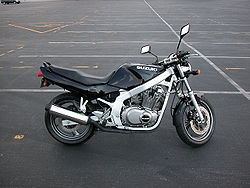Difference between revisions of "Suzuki GS series"
m (Bot: Adding {{Suzuki}}) |
|||
| Line 1: | Line 1: | ||
[[Image:Gs550e 01.jpg|thumb|250px|1997 Suzuki GS500E]] | [[Image:Gs550e 01.jpg|thumb|250px|1997 Suzuki GS500E]] | ||
From 1976 to 1987, [[Suzuki]] produced its GS line of [[motorcycle]]s. | From 1976 to 1987, [[Suzuki]] produced its GS line of [[motorcycle]]s. | ||
These motorcycles had air-cooled [[DOHC]] engines, which spanned a wide | These motorcycles had air-cooled [[DOHC]] engines with 2 valves per cylinder (as opposed to the [[:Category:Suzuki GSX series|GSX series]] which had four valves per cylinder), which spanned a wide range of cylinder capacities. It is considered to be a [[Universal Japanese Motorcycle]]. | ||
range of cylinder capacities. It is considered to be a | |||
[[Universal Japanese Motorcycle]]. | |||
When introduced in 1976, Suzuki offered the GS750, GS550 and GS400 models. | When introduced in 1976, Suzuki offered the GS750, GS550 and GS400 models. | ||
Revision as of 15:04, 5 December 2010
From 1976 to 1987, Suzuki produced its GS line of motorcycles. These motorcycles had air-cooled DOHC engines with 2 valves per cylinder (as opposed to the GSX series which had four valves per cylinder), which spanned a wide range of cylinder capacities. It is considered to be a Universal Japanese Motorcycle.
When introduced in 1976, Suzuki offered the GS750, GS550 and GS400 models. Earlier Suzuki motorcycles were two-stroke.
As the flagship of the Suzuki line, the GS series was succeeded by Suzuki's GSX and then GSX-R motorcycles, which had oil (GSX) or liquid cooled (GSX-R) engines. However, the GS series is still produced as relatively affordable bikes, possibly used by learners in some jurisdictions, such as the GS500E (naked) and GS500F (fairing).
Links:
Classic GS resources
GS info & forum
| |||||||||||||||||
